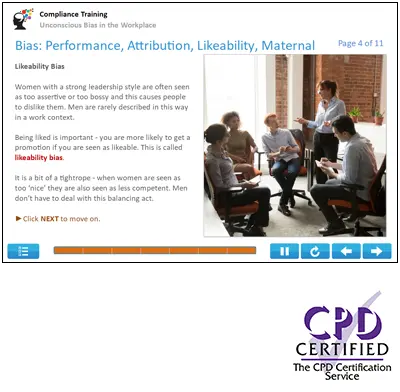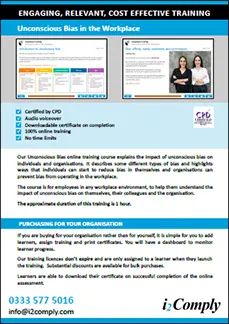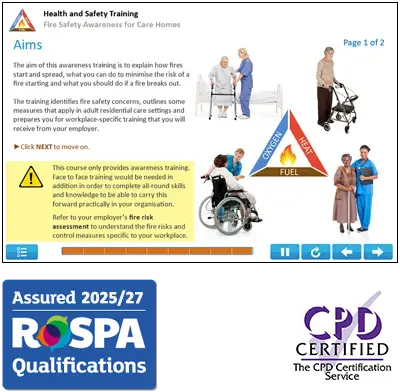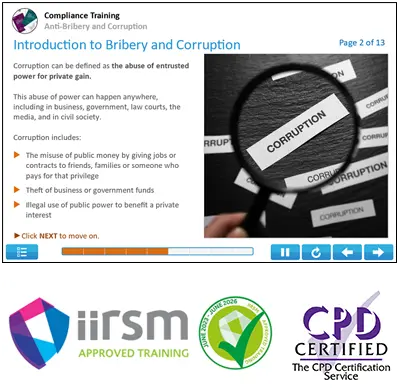Discounts Available For Bulk Purchases
| No. of total licenses |
% saving |
|---|---|
| 1 - 9 | - |
| 10 - 19 | 10% |
| 20 - 49 | 20% |
| 50 - 99 | 25% |
| 100 - 199 | 30% |
| 200 - 499 | 40% |
| 500 - 999 | 50% |
| 1000 + | 60% |
Online Unconscious Bias Training Course
£17.50 + £3.50 VAT
- Certified by CPD
- Audio voiceover
- Approximate course duration of 1 hour
- Downloadable certificate on completion
- 100% online training
This online Unconscious Bias training course explains the impact of unconscious bias on people and organisations.
This course describes what unconscious bias is and how it can have a negative impact on the quality of your decisions and behaviour at work. It describes the different kinds of bias and what steps you can take to reduce the impact of bias at work and in your life in general. It also highlights the importance for organisations to design processes that prevent unconscious bias having a negative effect in the workplace.
Who is Unconscious Bias training for?
The course is useful for employees in any work environment. It helps them understand the impact of unconscious bias on themselves, their colleagues and their organisation.
Reviewed and approved by lead bodies
The training course complies with the Continuing Professional Development (CPD) guidelines and is accredited by the CPD Certification Service.
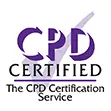
Course learning outcomes
After completing the course you will be able to:
- Define unconscious bias.
- Outline how stereotypes can affect behaviour.
- Describe the impact on businesses of unconscious bias.
- Define, and give examples of, different types of bias.
- Identify ways to reduce bias.
Example course pages
You can see below some sample screens from our Unconscious Bias in The Workplace training course. The course contains easy to follow material and interactive activities, which will keep you engaged throughout the training.
(Click below to view Unconscious Bias training example screens)

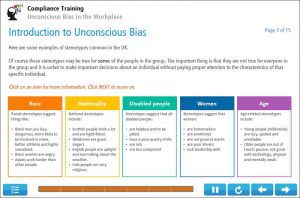
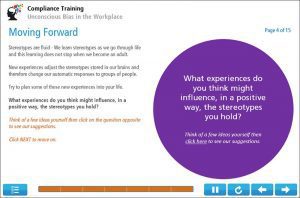
Course content
The online training course contains the following 5 topics:
1 – Introduction to Unconscious Bias
The first topic is about stereotypes and behaviour. It identifies the ways in which unconscious bias can impact your decisions. It describes how bias affects some groups more than others. Finally the topic describes the impact that unconscious bias can have on a business.
2 – Bias: affinity, name, conformity and confirmation
The second topic describes four types of bias – affinity, name, conformity and confirmation.
3 – Bias: performance, attribution, likeability and maternal
The third topic describes four more types of bias – performance, attribution, likeability and maternal.
4 – Three effects – halo, horns and contrast
Topic 4 describes three effects that increase bias – the halo, horns and contrast effects.
5 – Moving Forward
The final topic discusses the limitations of unconscious bias training. Then it identifies ways you can reduce your own bias. It also identifies ways that an organisation can reduce the impact of bias.
Course assessment
You can take try the assessment as soon as you have completed all five topics. The course creates the assessment from question banks so the questions vary every time you do the assessment. This means the training is suitable as initial and refresher training.
You can take the test as often as you need to. You will get feedback and learn from any mistakes.
Course certificate
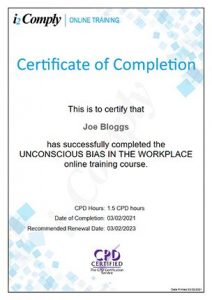
When you have passed the Unconscious Bias training course, you can download your certificate.
Your certificate will include the CPD logo so you can use it as evidence of compliance.
How long is this Unconscious Bias course certificate valid for?
Our Unconscious Bias in The Workplace certificate does not expire. However, we recommend refreshing the training after a 2 year period to ensure that you and your employees retain important information, can spot signs of unconscious bias in the workplace and know how to reduce bias.
Course reviews
See what our customers think about our course and Read our Unconscious Bias in The Workplace Course Reviews. and see what other participants have posted about this online course.
Want to leave a review? Your opinion is very important to us, so you are welcome to leave a review on Reviews.io or leave a review on Google.
What is unconscious bias?
Unconscious biases are associations that you hold subconsciously, and they affect the way you think and feel about others around you. Very often those associations will not be accurate or fair about the specific people you meet and work with.
Unconscious bias affects everyone. It is influenced by your background, personal experiences, societal stereotypes and cultural context. Unconscious bias can influence your attitudes and behaviours towards other people. Also, it can influence decision making in the workplace and contribute to inequality during recruitment, appraisals and promotions.
What are the benefits of Unconscious Bias in The Workplace Training?
Unconscious bias can harm both individuals and companies. This unconscious bias in the workplace training will help you and your employees to achieve the following benefits:
Unconscious bias training helps to make people aware that unconscious bias exists and helps them understand their own biases. This allows them to take steps to slow down their decision-making process and reduce the likelihood that bias will influence their decisions at work or in their personal life.
The training will enable employees to work towards inclusion and improve their workplace relationships and professional interactions. This will create a positive work environment and improve employees’ morale.
The unconscious bias in the workplace training will help you and your employees to address bias in specific situations, such as recruitment and performance management. As a result, your company will acquire a wider pool of talent and maintain employees’ motivation and enthusiasm. In fact, employees who perceive bias against them at work are more likely to be disengaged, plan to leave their jobs or withhold ideas and market solutions. This means that reducing bias in the workplace will encourage employees to stay and lead to increased business productivity and opportunities.
Are you ready to get started?
To book Unconscious Bias in The Workplace online training course simply click the ‘Add to basket’ button at the top right of the page, click on the basket icon and proceed to checkout.
If you are looking to purchase for your team, remember that our licences don’t expire and are only used when a learner starts a course. Any unused licences stay in your account until you need to use them. So, take advantage of our bulk purchase discounts, starting from orders of 10 licences per course. Discounts are automatically applied at checkout.
Other online Regulatory Compliance courses
I2Comply provides a variety of online regulatory compliance courses both for individuals and organisations. Click on the course titles below to learn about our regulatory compliance courses or see a full list of courses here.
- Anti-Money Laundering Training Course
- Bribery Act 2010 Training Course
- Cyber Security Training Course
- Data Protection and the GDPR Course
- Data Protection and the GDPR (Advanced) Course
- Disability Awareness Training Course
- Freedom of Information and the Law Course
- Mental Health Awareness Course
- Equality and Diversity Awareness Course
- Modern Slavery Awareness Course
Do you have any questions about Unconscious Bias training?
If you still have questions about Unconscious Bias in The Workplace training, don’t hesitate to contact a member of our team by emailing support@i2comply.com or call the support line on 0333 5775 017.
Also, visit our Help & Support page, where you will find FAQs about our online training courses.
Request an online training quote
Whether you are looking to train a small team or an entire business, we’re here to help. Let us know your online training requirements and we’ll provide you with a quote.
£17.50 + £3.50 VAT
Discounts Available For Bulk Purchases
| No. of total licenses |
% saving |
|---|---|
| 1 - 9 | - |
| 10 - 19 | 10% |
| 20 - 49 | 20% |
| 50 - 99 | 25% |
| 100 - 199 | 30% |
| 200 - 499 | 40% |
| 500 - 999 | 50% |
| 1000 + | 60% |
